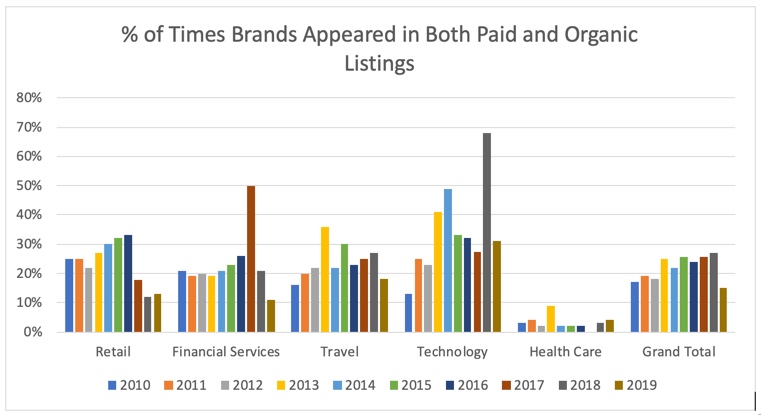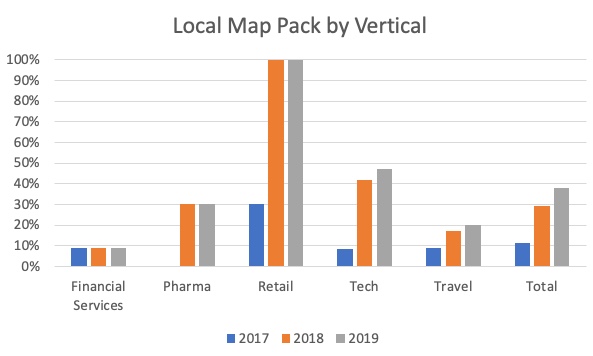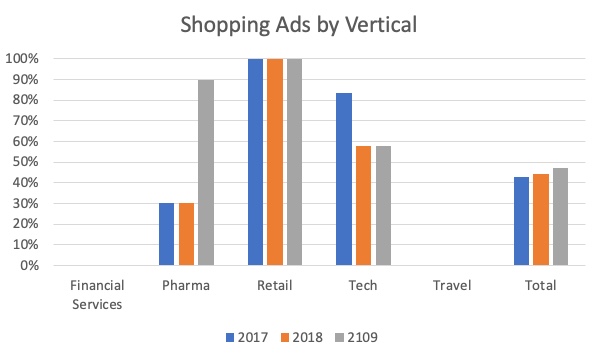
The search landscape has always been one that is evolving. Right now the big discussion is around Google’s control on how much search traffic goes to publishers vs. stays on Google.com.
This might end up being a really big point for Google when it comes down to challenging the long-held point of view that competition is just one click away.
Over the past ten years that I’ve been writing for this publication, I’ve written an article each year where I review how paid and organic search can work together, and how brands appear in search listings. This article over the past few years has started to evolve into how Google has changed the search page. These changes include the inclusion of more paid search results, shopping, and local listings. As you will see from the data there is certainly a trend that is fueled by both Google’s growth objectives as a publicly-traded company, as well as consumer behavior shifts (that are, mobile and local).
The first piece is the overlap of paid and organic listings. What I’m tracking here is the number of times a brand appears in both paid and organic search results as a percentage of total paid results. For example, if there are three paid search ads, and GEICO, Progressive and Liberty Mutual all appear in both the paid and organic listings that would score 100%. I’ve been tracking five verticals since 2010. What’s really interesting is over the past few years the amount of overlap has gone up on average. However, this year the overlap dropped by 44% year over year. This had a lot to do with the drops across financial services, travel, and technology.

Source: Google Search Data
Factors driving this change
I think this trend is driven by two factors:
- Increasing competition & costs – CPCs (cost per clicks) were up by five percent between Q4 2018 and Q1 2019
- Rise of other areas of optimization – Local Listings/Maps/Google My Business and Shopping. These additional areas have provided both a distraction and a release valve for additional traffic, and higher ROI.

Source: Google Search Data
So what has been happening to the other areas of optimization, especially local and shopping? I have also been tracking these areas over the last three years. The change is exactly what you would have expected. Over the past three years, the percent of search terms that have local listings has increased more than three times, from 11% in 2017 to 38% in 2019. Retail continues to have 100% of listings with the map pack. This validates the importance to both Google, brands, and consumers of having a local presence. Also gives additional credence to optimizing and cleansing your location data, not just on Google, but across the web.

Source: Google Search Data
Shopping ads have come on in a big way
Shopping ads have also continued to have a strong presence and have grown slightly. They are up from 43% in 2017 to 47% in 2019. Shopping ads provide a more visual experience for the consumer, and some very strong conversion rates for brands. Google has also been continuing to evolve their shopping product announcing a redesigned shopping experience in May. This included new ad formats, online to in-store options, and Smart Campaigns (which help encourage SMBs to get into the game). All these changes and enhancements demonstrate a commitment to the product and the value to both consumers and brands.
What should you be doing as a search marketer?
So what is the impact of this data to us as search marketers? I think there are two key takeaways:
- Search is more than just keyword listings and optimizing your website. Yes, SEO and paid search are critical, but extending beyond that is also very important. Optimizing your product feed, and local listings are very important to success. You must think about how you are there for your consumers regardless of what they are trying to do, buy, visit, or call.
- Having a winning strategy for critical search terms is important. You might not be able to afford top placement for paid search, or technical issues might be preventing you from having the top organic listing. However, that doesn’t mean you don’t need to have a presence for those terms over the long term. These could be choosing specific times of the day, or including schema markup for event listings. Whatever the case may be, there are now more ways than ever to be found, and having a very thoughtful strategy for your brand is key.
The search engine results page will continue to evolve as consumer behavior and technology evolves. Think about the continued expectations of online to offline buying behavior, real-time inventory, or the impact 5G will have on the marketplace. Remind yourself to take a look around at a macro-level to see the trends vs. always focusing on detailed keyword level optimizations. You will often find some great trends to help put your strategy in context.
P.S. Special thanks to Audrey Goodrick who helped pull together this data. Thank you for your help this summer Audrey.
Related reading
The powerful driving source of any business is its competition. Three competitive research tools that provide highly actionable insights.
Google never confirmed its existence, but many SEOs believe that Google Sandbox exists. So, does it exist in 2019? If yes, how to avoid getting affected?
While Google is an obvious “horse to bet on,” ubiquity, UX and utility will dominate the voice-search innovation race in 2020 and beyond.
This marketing news is not the copyright of Scott.Services – please click here to see the original source of this article. Author: Jason Tabeling
For more SEO, PPC, internet marketing news please check out https://news.scott.services
Why not check out our SEO, PPC marketing services at https://www.scott.services
We’re also on:
https://www.facebook.com/scottdotservices/
https://twitter.com/scottdsmith
https://plus.google.com/112865305341039147737
The post Search engine results: The ten year evolution appeared first on Scott.Services Online Marketing News.
source https://news.scott.services/search-engine-results-the-ten-year-evolution/




No comments:
Post a Comment